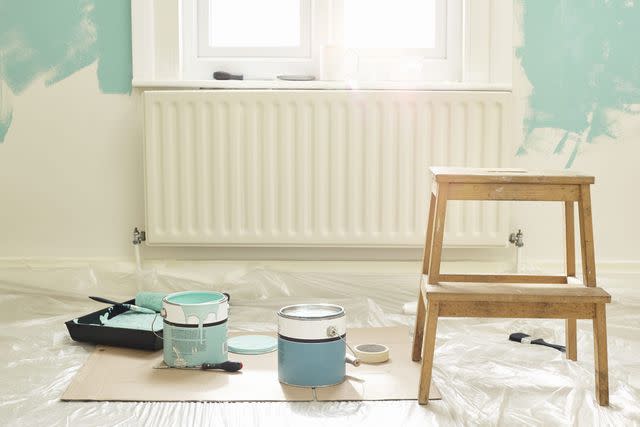How Long Paint Lasts—and How to Tell If a Can Has Expired
Be prepared for future projects by increasing the shelf life of your leftover paint.

If you're a homeowner with a DIY streak, then you're almost guaranteed to have a corner of your basement, garage, or shed stacked with partly-used paint cans: a little bit of the grassy green you used for the nursery, a half-full can of gray from your half-bath makeover, and a few inches of the terra-cotta accent shade in your living room.
Whether these paints last until your next project—or until you need to touch up the original one—depends on a variety of factors, including whether the paint is oil-based or latex, how you used it, and how and where you store it. To help you determine whether or not last year's can is expired, we tapped Ed Edrosa, senior project manager at Behr, and Dennis Fiorilli, director of product excellence at Sherwin-Williams; here, they detail how long paint should last—and how to make sure yours stays fresh as long as possible.
Related:Your Step-By-Step Guide to Painting the Perfect Wall
How Long Does Paint Last?
Though each brand will have its own guidelines for an opened or unopened can's shelf life, you can expect interior paint to last several years—and often past the listed expiration, if properly stored. Behr's water-based paints should be good for two years, says Edrosa, while Sherwin-Williams' cans boast a three-year shelf life, says Fiorilli.
Water-Based vs. Oil-Based Paint
The quality of the paint, color, and gloss finish don't affect the shelf life, but if you need to store paint in a garage or shed, oil-based paint may last longer than water-based. "If the paint is stored in an environment that has fluctuating temperatures, like freezing and thawing temperatures, a water-based paint is more susceptible to degradation in its liquid formed compared to oil-based paint," says Edrosa.

How to Identify Rotten Paint
Trying to use old paint might present a variety of problems—some minor and some major. Two you can't work around are a ruined consistency or a sour smell.
Chunky Consistency
"After stirring or mixing, the consistency should be smooth; there should be no chunks or lumps, or cottage cheese-like texture, in the paint," says Edrosa.
Sour Smell
While you may not love the smell of fresh paint, spoiled paint has a scent that's much worse. "Paint that is beyond its shelf life can develop a rancid, sometimes rotten-egg odor," says Edrosa. If you open a can and find either of these problems, dispose of the paint and buy new.
Can You Use Old or Expired Paint?
In many cases, paint stored away from extreme temperatures and humidity is still useable long after its listed shelf life. If your paint doesn't have a spoiled odor or consistency, you can use it for touchups or new projects—though it may not result in a perfect finished product. "The product might be too thick to apply, and not flow and level to an even finish," says Edrosa.
Skinning is another concern with older paint. "Skinning is a fine layer of dry paint film on the top of liquid paint that has been exposed to air for a period of time,” says Edrosa. "If there is skinning of the paint in the can, the small, dried particles in the paint might leave blemishes on the painted surface when applied.”
The ingredients in the paint can also separate, requiring a heavier stir than you may be able to do on your own. "Having an old paint can shaken in store can be helpful, especially when there is syneresis, or color separation," says Edrosa.
Related:8 Paint Colors That Will Never Go Out of Style
How to Make Paint Last Longer
Proper use and storage will allow your paint to live its longest—and best—life. The key factor in deciding how and where to store paint is to choose a conditioned space, like a closet or a basement. "We do not recommend storing it in a garage, where the paint can see major temperature swings,” says Fiorilli. Choose a dry spot where the temperature stays between 50 and 90 degrees Fahrenheit, keeping your paint protected from hot spells, excessive humidity, or the possibility of freezing, says Edrosa.
Try these three additional expert tips to keep your paint fresher for longer.
Keep Your Paint Clean
To prevent adding bacteria to the paint, always pour into a tray or cup before painting, and dispose of the remainder instead of pouring it back into the can. "Don't dip your brush and roller directly into the can, and never leave paint brushes and roller covers inside the can or container," says Edrosa. "It may contaminate the paint, introduce microbes, and cause premature spoilage."
Seal the Container
Secure an airtight lid onto the paint can or container to minimize the paint's air exposure while it's in storage. "Some folks place a sheet of plastic wrap between the lid and the can's rim before closing," says Edrosa. "We recommend turning the can upside down when the lid is completely secured and closed—the wet paint would be pressed against the inside of the lid, which creates an airtight seal."
Choose the Right Storage Container
Leftover paint can be kept in the original can. "If the can is damaged, or the rim is full of paint—not allowing the lid to go on correctly—we suggest transferring the paint into a new can or container that can be sealed," says Fiorilli. Buy a new, smaller paint can to store your remaining product, or opt for a glass or plastic container with a tight-fitting lid. "If you are not using the original paint can, your storage container should not be much bigger than the amount of paint that is left to limit air exposure," says Edrosa.

